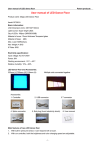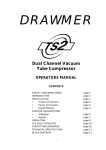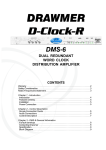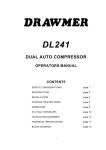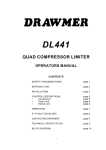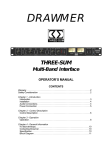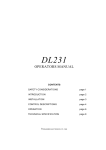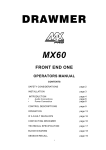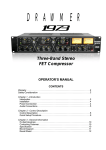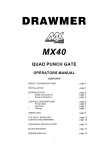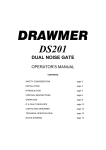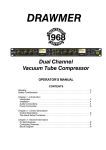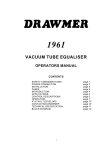Download Drawmer DF330 Specifications
Transcript
DF330 UNIVERSAL NOISE FILTER OPERATORS MANUAL CONTENTS SAFETY CONSIDERATIONS page 1 INTRODUCTION page 2 INSTALLATION page 3 CONTROL DESCRIPTIONS High Pass filter Expander Filter Linking page page page page page OPERATION page 7 APPLICATIONS page 9 IF A FAULT DEVELOPS page 10 CONTACTING DRAWMER page 10 TECHNICAL SPECIFICATION page 11 BLOCK DIAGRAM page 12 5 5 5 5 6 COPYRIGHT This manual is copyrighted © 2001 by Drawmer Electronics, Ltd. With all rights reserved. Under copyright laws, this manual may not be duplicated in whole or in part without the written consent of Drawmer. ONE YEAR LIMITED WARRANTY Drawmer Electronics Ltd., warrants the Drawmer DF330 audio processor to conform substantially to the specifications of this manual for a period of one year from the original date of purchase when used in accordance with the specifications detailed in this manual. In the case of a valid warranty claim, your sole and exclusive remedy and Drawmer’s entire liability under any theory of liability will be to, at Drawmer’s discretion, repair or replace the product without charge, or, if not possible, to refund the purchase price to you. This warranty is not transferable. It applies only to the original purchaser of the product. For warranty service please call your local Drawmer dealer. Alternatively call Drawmer Electronics Ltd. at +44 (0)1709 527574. Then ship the defective product, with transportation and insurance charges pre-paid, to Drawmer Electronics Ltd., Coleman Street, Parkgate, Rotherham, S62 6EL UK. Write the RA number in large letters in a prominent position on the shipping box. Enclose your name, address, telephone number, copy of the original sales invoice and a detailed description of the problem. Drawmer will not accept responsibility for loss or damage during transit. This warranty is void if the product has been damaged by misuse, modification or unauthorised repair. THIS WARRANTY IS IN LIEU OF ALL WARRANTIES, WHETHER ORAL OR WRITTEN, EXPRESSED, IMPLIED OR STATUTORY. DRAWMER MAKES NO OTHER WARRANTY EITHER EXPRESS OR IMPLIED, INCLUDING, WITHOUT LIMITATION, ANY IMPLIED WARRANTIES OF MERCHANTABILITY, FITNESS FOR A PARTICULAR PURPOSE, OR NON-INFRINGEMENT. PURCHASER’S SOLE AND EXCLUSIVE REMEDY UNDER THIS WARRANTY SHALL BE REPAIR OR REPLACEMENT AS SPECIFIED HEREIN. IN NO EVENT WILL DRAWMER ELECTRONICS LTD. BE LIABLE FOR ANY DIRECT, INDIRECT, SPECIAL, INCIDENTAL OR CONSEQUENTIAL DAMAGES RESULTING FROM ANY DEFECT IN THE PRODUCT, INCLUDING LOST PROFITS, DAMAGE TO PROPERTY, AND, TO THE EXTENT PERMITTED BY LAW, DAMAGE FOR PERSONAL INJURY, EVEN IF DRAWMER HAS BEEN ADVISED OF THE POSSIBILITY OF SUCH DAMAGES. Some states and specific countries do not allow the exclusion of implied warranties or limitations on how long an implied warranty may last, so the above limitations may not apply to you. This warranty gives you specific legal rights. You may have additional rights that vary from state to state, and country to country. In the interests of product development, Drawmer reserve the right to modify or improve specifications of this product at any time, without prior notice. 1 DF330 OPERATOR’S MANUAL DRAWMER DF330 UNIVERSAL NOISE FILTER SAFETY CONSIDERATIONS CAUTION - MAINS FUSE TO REDUCE THE RISK OF FIRE REPLACE THE MAINS FUSE ONLY WITH A FUSE THAT CONFORMS TO IEC 127-2. 250 VOLT WORKING, TIME DELAY TYPE AND BODY SIZE OF 20mm x 5mm. THE MAINS INPUT FUSE MUST BE RATED AT 125mA WHERE THE MAINS INPUT VOLTAGE SWITCH IS SET TO 230 VOLTS AC. AND 250mA WHERE THE MAINS INPUT VOLTAGE IS 115 VOLTS AC. CAUTION - MAINS CABLE DO NOT ATTEMPT TO CHANGE OR TAMPER WITH THE SUPPLIED MAINS CABLE. CAUTION - SERVICING DO NOT PERFORM ANY SERVICING. REFER ALL SERVICING TO QUALIFIED SERVICE PERSONNEL. WARNING TO REDUCE THE RISK OF FIRE OR ELECTRIC SHOCK DO NOT EXPOSE THIS EQUIPMENT TO RAIN OR MOISTURE. 2 DF330 OPERATOR’S MANUAL INTRODUCTION The Drawmer DF330 is a single-ended, high quality noise reduction processor which may be used to significantly reduce the subjective effect of unwanted noise that might be present in an audio signal. Unlike tape noise reductions systems, the DF330 does not rely on the encoding of the original signal and it is effective not only against tape noise, but also against noise generated by signal processors or electronic instruments. High quality components are used throughout to ensure the cleanest possible signal path from input to output. Conventional gates or expanders can only remove noise during low level sections or pauses in the material being processed but the DF330 is active at all times, regardless of the signal level. The DF330 works on the established psycho acoustic principle that noise is masked or shadowed by high signal levels or by signals containing a significant amount of high frequency information. When such signals are present, no processing is necessary. In the situation where the signal level is low or there is little high frequency content to mask the noise, then the noise becomes audible. Two different principles are applied simultaneously by the DF330 resulting in a significant lowering of the perceived noise level yet without introducing any undesirable side effects such as noise pumping or noticeable loss of high frequency content. Firstly, a low level expander, with a choice of three expansion ratios, may be used to unobtrusively close down the signal path when the signal falls below a preset threshold, as set by the operator. This expander has fully automatic attack, variable release time and the user may select from three degrees of attenuation so that, if preferred, the signal may be attenuated rather than muted by the expander action. This latter feature, combined with a low expansion ratio, may be used to increase the dynamic range of low level programme material with a subsequent improvement in signal to noise ratio. Automatic attack is an essential feature of a high quality expander. Any vocal signal will be almost impossible to capture correctly using manual attack. This is because almost every word in every language has a different attack characteristic. A slow attack would cause 't' sounds to become 'e' due to the loss of the initial transient. A fast attack will tend to 'click' or sound 'scratchy' when a slow rising signal is present. The DF330 eliminates this problem by sensing the speed of the rising envelope, independently of the frequency and constantly adjusts the attack time accordingly. Secondly, a voltage controlled low-pass filter tracks the dynamics of the input signal and so reduces the audio bandwidth of the signal path at such times as the full bandwidth is not required, with a consequent reduction in high frequency noise. This filter has two modes of operation, Manual and Auto. In Manual mode, the user sets a threshold below which the filter will start to close as the input signal level falls. This mode is very flexible and is useful on a variety of sound sources from complete mixes to individual instruments. It also allows the user to decide on the degree of processing necessary: High quality programme material needs little processing whereas an excessively noisy source such as an audio cassette without noise reduction may warrant more severe treatment. In this case, the user can compromise between the degree of noise that is acceptable and any loss of brightness that heavy processing may cause. 3 DF330 OPERATOR’S MANUAL Auto mode causes the filter to track the frequency content of the input signal rather than its amplitude and so even low level passages may be processed without any significant loss of high frequency content. Which mode to select depends on the character of the material being processed and this may be decided empirically by the user. INSTALLATION The DF330 is designed for standard 19" rack mounting and occupies 1U of rack space. Avoid mounting the unit directly above power amplifiers or power supplies that radiate significant amounts of heat and always connect the mains earth to the unit. Fibre or plastic washers may be used to prevent the front panel becoming marked by the mounting bolts. AUDIO CONNECTIONS INPUTS and OUTPUTS: Input and output connections are provided for use at +4dBu via balanced XLRs or at -10dBu via unbalanced jacks. It is permissible to use both +4dBu and -10dBu outputs simultaneously but only one set of inputs (jack or XLR) will operate correctly at any one time. If un-balanced operation at +4dBu is required, simply connect the un-used terminal to Ground inside the XLR cable plugs. This applies to both inputs and outputs. The wiring convention for XLR being: pin 1 Ground, pin 2 Hot and pin 3 Cold. For use with unbalanced systems, the Cold pin (3) must be grounded at both input and output XLRs. The input signal level should be adjusted to be within the range of the unit; if the +6dB LED is constantly lit, the drive to the unit should be reduced at source. Conversely, if the -6dB LED seldom or never lights, the input signal should be increased. If earth loop hum problems are encountered, don't disconnect the mains earth but instead, try disconnecting the signal screen inside the XLR connector at one end of the cable connecting the DF330 to the patchbay. If such measures are necessary, balanced operation is recommended. 4 DF330 OPERATOR’S MANUAL POWER CONNECTION The unit will have been supplied with a power cable suitable for domestic power outlets in your country. For your own safety it is important that you use this cable. The unit should always be connected to the mains supply earth using this cable. If for some reason the unit is to be used at a mains input operating voltage which is different to that as supplied, the following procedure must be carried out. 1: Disconnect the unit from the mains. 2: Using a number 1 size pozidrive screwdriver, remove the two self-tapping screws holding the voltage selection switch cover plate on the rear panel. 3: Remove the cover plate and slide the switch fully to its opposite end. 4: Rotate the cover plate one half turn, (180E) and refit the two screws. 5: Replace with a correctly rated fuse for the selected operation voltage. 6: Re-connect to mains power source. 5 DF330 OPERATOR’S MANUAL CONTROL DESCRIPTION A 'Traffic Light' LED meter monitors input level at -6dB, 0dB and +6dB. HIGH PASS FILTER 50Hz Hi-Pass When switched to In, this filter affects both the signal path and the side chain detector circuitry. It may be used to remove subsonic material from the programme being processed and has a slope of 18dB per octave. It also prevents high levels of extremely low frequency signal from opening the filter. EXPANDER SECTION Threshold The expander threshold is continuously variable from -50dB to +10dB. The amount of gain reduction taking place is shown on a five section LED meter. Ratio A three position switch allows expansion ratios of 1:2, 1:5 or 1:20 to be selected. Release The expander release time is user variable from 0.05s (50ms) to 5 seconds. In/Out Permits the expander to be bypassed independently of the filter section. Attn. Attenuation of the expander is controlled by a three position switch with options of -10dB (the least effect), -20dB or -40dB (maximum effect). A five segment LED display shows the expander gain reduction. FILTER SECTION Man/Auto Switches the filter section to Manual or Auto Mode. In Manual mode, the filter frequency depends on the level of the input signal as well as its frequency. In Auto, the filter frequency is influenced essentially by the frequency content of the signal being processed and not by its level. Threshold In Manual mode, the Threshold control determines how the filter tracks the incoming signal level. Signals above threshold tend to increase filter frequency whilst lower levels tend to close the filter. Clockwise rotation sets a lower threshold level which opens the filter. 6 DF330 OPERATOR’S MANUAL In Auto mode, the Threshold control is set so that the filter closes fully when only noise is present. i.e. tape hiss between tracks and so on. Above this level, the filter frequency is determined by the spectral content of the input signal and is essentially independent of level. In/Out Allows the filter to be switched in or out of circuit independently of the expander. When switched out, the filter is forced open but the display is disabled. A nine segment LED display dynamically shows the filter frequency. Bypass Enables the output of the DF330 to be compared with the original input signal. Although individual In/Out switches are provided for both expanders and filters, doing an A-B comparison in stereo would involve the operating of four switches. LINKING Stereo Link Causes both channels to track identically so that a stereo signal may be processed without introducing unnatural image shifts. In this mode, the left and right channel control settings will be averaged in the expander and peak linked in the filter, so it is best to set both channels to the same settings to avoid confusion. This also applies to the in/out switches. A LED indicates Stereo Linking on. 7 DF330 OPERATOR’S MANUAL OPERATION The unit should be connected in line with the signal to be processed, preferably via the console's insert points. See the section 'INSTALLATION' for details. Setting up is identical for mono or stereo operation, the only proviso being that for stereo use, the Stereo Link switch must be on and both sets of controls should be set similarly. The expander is best set up independently of the filter, so at this point, the filter should be switched out. Now the user must decide whether a sharp or progressive action is required. For a sharp gate-like action, a high ratio and high degree of attenuation should be chosen, together with a fast release time. If, on the other hand, a less obtrusive action is called for, a lower ratio combined with the minimum attenuation setting and a slower release time will allow the threshold level to be increased slightly so that dynamic range expansion can be implemented on low level signals. This choice depends entirely on the nature of the material being processed, so a period of experimentation is recommended which will enable the user to become familiar with the operation of the DF330 and obtain the best possible results from it. It is essential that the expander should only affect low level signals close to the noise floor and so careful setting of the threshold is essential. The attack time of the expander is completely automatic, adjusting itself to suit the attack characteristic of the signal being processed, regardless of frequency. This will be of particular value when cleaning up a vocal track. Once the expander is set for optimum performance, it should be switched out and the filter switched in. The filter can be used in either Manual or Auto mode, depending on the type of material being processed. In the Manual mode, the threshold should be set so that moderate to loud sounds cause the filter display to show the full 20kHz and this will probably fall to 10 or 12kHz between beats in the case of pop music. The next step is to play a quieter part of the programme and check that the filter action is having a beneficial effect on the noise content. This may be checked by switching the bypass switch and comparing the treated and untreated signals. If the noise is still too obtrusive, a higher threshold level may be set, but if on the other hand there is a noticeable lack of high frequencies and noise is not a problem, then the threshold level may be reduced. On very noisy programme material, the setting up procedure is a matter of choosing an acceptable compromise between background noise and some loss of high frequency definition. In Auto mode, the Threshold control should be set up with only background noise being fed into the unit; in the case of a recording, this might be a section of blank tape before the programme starts. The filter Threshold should be turned clockwise until the filter just starts to open in response to the noise and then it should be backed off slightly so that it is once again closed. This will be evident by watching the filter frequency display. At this stage, the programme material may be introduced and operation should be completely automatic. Signal above the threshold is analyzed for frequency content and the filter is in turn controlled so that it tracks the upper frequency limit of the programme. Because the filter response is extremely fast, sudden changes in the spectral content can be accommodated, and, because the signal level has little effect on the filter action, the filter will track the frequency of the input even through fades. When the signal level 8 DF330 OPERATOR’S MANUAL reaches the threshold level, the filter will stop tracking and start to shut as the level drops. It should not be inferred that the Auto setting will always produce the best results regardless of the type of programme material being processed. It is most suitable for programme material that varies drastically in level but where the low level sections still contain wanted high frequencies. However, if the programme contains significantly more low frequency content than high, then the Manual mode is likely to give better results. If in doubt, try both Manual and Auto settings and decide which is best for the material being processed. Once both expander and filter sections have been set up, they should both be switched into circuit and their effect evaluated, comparing with the un-treated signal using the bypass switch. 9 DF330 OPERATOR’S MANUAL APPLICATIONS Single ended noise reduction systems can be used extensively in all areas of music production from tracking through to mastering and even in cassette duplication. At the recording tracks stage, the DF330 may be used to clean up signals from an electric guitar that is being recorded with a microphone, noisy electronic keyboard instruments and special effects cartridge machines. The effect on noisy direct injection guitar processors is often dramatic. Individual mixer channels may be treated in this way or a stereo subgroup created in which case the DF330 should be connected via the subgroup insert points and the Stereo Link switched ON. At the mixing stage, particularly noisy signals may again be assigned to a subgroup for stereo processing. If conventional gates are being used on some of the tracks, then processing all the others with the DF330 will produce incredibly quiet results, even with a semi-pro multitrack machine. On the other hand, it may be desirable to process the entire stereo mix, in which case the DF330 should be connected via the master stereo insert points. If the mix is not unduly noisy, then the Manual mode is likely to be the least obtrusive in operation. If however, the noise contamination is severe, Auto may give the best compromise between noise and loss of high end transparency. For cassette duplication where the master tape is also a cassette, the DF330 can be used to greatly increase the quality of the copies. Ideally, the master cassette should be produced with additional brightness to compensate for loss of top in the duplication process, but if this is not possible, the combination of a DF330 and some form of acoustic enhancement will often solve the problem. This combination of units is also suitable for treating old analogue master tapes to prepare digital copies for CD release since the noise level within the DF330 is equal to that of the CD. 10 DF330 OPERATOR’S MANUAL IF A FAULT DEVELOPS For warranty service please call Drawmer Electronics Ltd. Or their nearest authorised service facility, giving full details of the difficulty. On receipt of this information, service or shipping instructions will be forwarded to you. No equipment should be returned under the warranty without prior consent from Drawmer or their authorised representative. For service claims under the warranty agreement a service Returns Authorisation (RA) number will be given. Write this RA number in large letters in a prominent position on the shipping box. Enclose your name, address, telephone number, copy of the original sales invoice and a detailed description of the problem. Authorised returns should be prepaid and must be insured. All Drawmer products are packaged in specially designed containers for protection. If the unit is to be returned, the original container must be used. If this container is not available, then the equipment should be packaged in substantial shock-proof material, capable of withstanding the handling for the transit. CONTACTING DRAWMER Drawmer Electronics Ltd., will be pleased to answer all application questions to enhance your usage of this equipment. Please address correspondence to: Drawmer (Technical Help line) : Coleman St.: Parkgate : Rotherham : S62 6EL : UK or, E-mail us on : [email protected] Drawmer dealers, Authorised service departments and other contact information can be obtained from our web pages on http://www.drawmer.com 11 DF330 OPERATOR’S MANUAL TECHNICAL SPECIFICATIONS INPUT IMPEDANCE XLR Jack 51K Ohm 10K Ohm NOMINAL INPUT LEVEL +4dBu (XLR), -10dBu (JACK) MAXIMUM INPUT LEVEL +21dBu (XLR), +7dBu (JACK) OUTPUT IMPEDANCE XLR Jack NOMINAL OUTPUT LEVEL +4dBu (XLR), -10dBu (JACK) MAXIMUM OUTPUT LEVEL +20dBu (XLR), +6dBu (JACK) BANDWIDTH 10Hz to 22KHz -1dB CROSSTALK @10kHz OUTPUT BALANCE Better than 40dB 20Hz to 10kHz INPUT CMR Better than 40dB 20Hz to 10kHz NOISE AT UNITY GAIN -93dB, ( 22Hz to 22KHz ) ref +4dBu DISTORTION Better than 0.025% at 100Hz, 1KHz and 10KHz ATTACK TIMES Expander: 50µS to 20mS ( Automatic ) Filter : 100µS POWER REQUIREMENTS 115Volt or 230Volt at 50-60Hz,13 Watts FUSE RATING 125mA for 230Volt, 250mA for 115Volt CONFORMING TO IEC 127-2 FUSE TYPE 20mm x 5mm, Class 3 Slo-Blo, 250Volt working CASE SIZE 482mm (w) x 44mm (h) x 200mm (d) WEIGHT (incl packaging) 3.4 Kgs 50 Ohm 100 Ohm Better than -80dB 12 DF330 OPERATOR’S MANUAL BLOCK DIAGRAM DF330 OPERATOR’S MANUAL 13
















